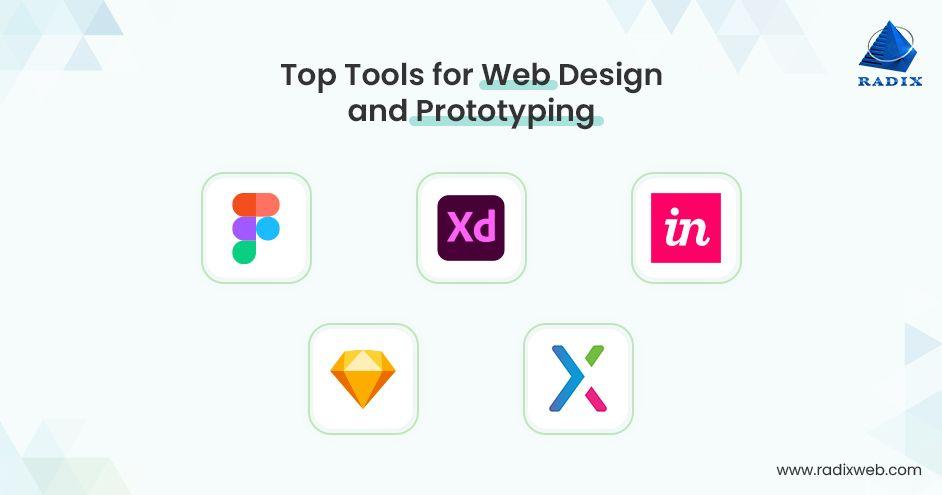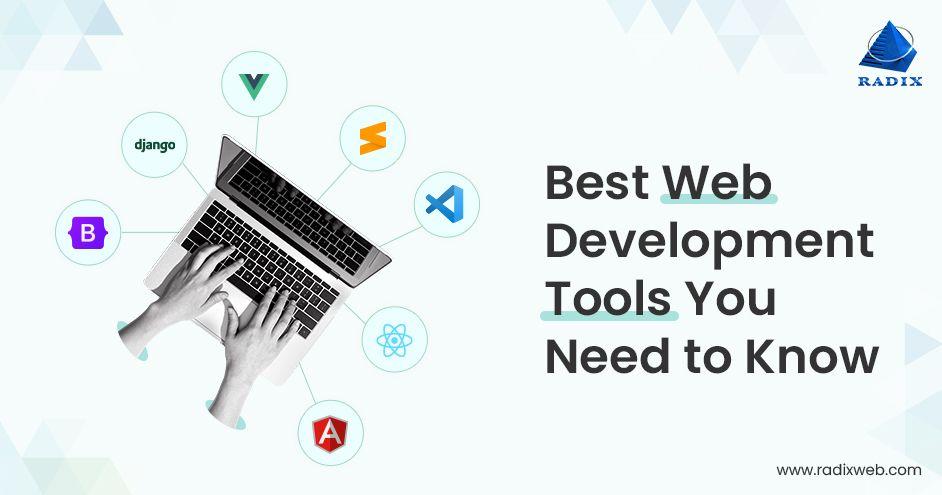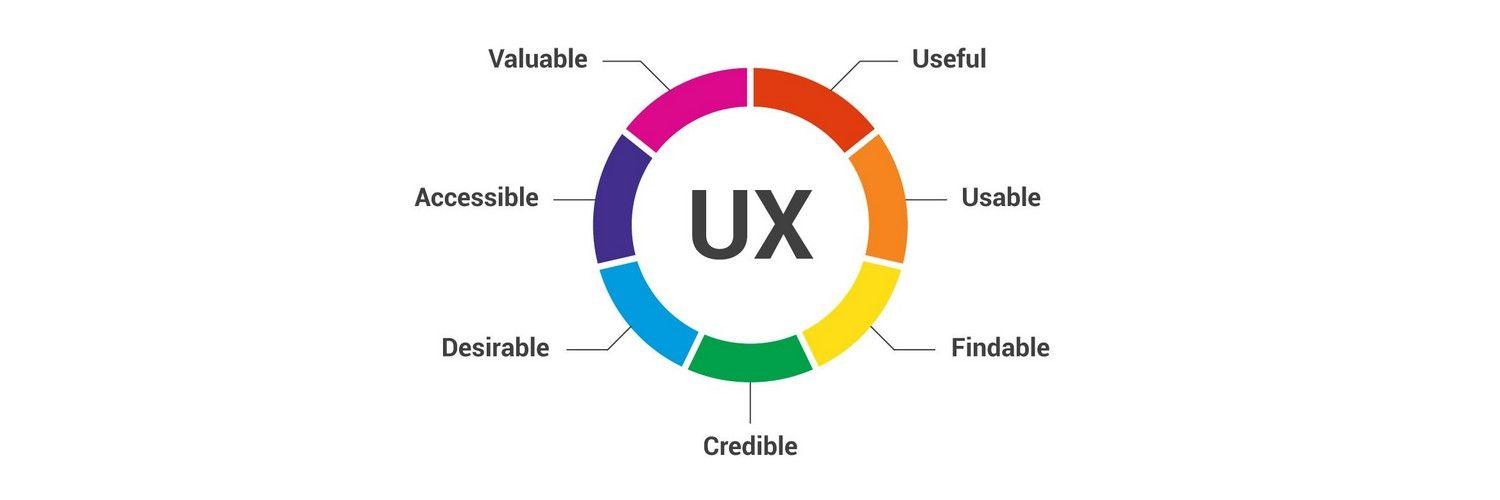
Introduction:
Hey there, aspiring web wizard! Whether you’re embarking on your very first project or you’re a seasoned developer looking to refresh your toolkit, the world of web development is constantly evolving. With new tools popping up every day, it can be overwhelming to find the right ones that fit your needs. That’s where we come in!
In this article, we’re diving into the 25 top web development tools for current_year that can elevate your projects and streamline your workflow. From powerful frameworks to intuitive design tools, we’ve curated a list that caters to developers of all skill levels. Plus, we’ll share some insider tips on how to choose the perfect tech stack for your unique projects.
So grab your favorite beverage, get comfy, and let’s navigate the exciting landscape of web development together! Your next big project is just a few clicks away.
Understanding the Landscape of Web Development Tools
In the rapidly evolving world of web development, choosing the right set of tools can significantly impact your productivity and the quality of your final product. With countless options available, can seem daunting. However, breaking it down into categories can make the process more manageable and fun!
When considering your toolkit, think about the primary tasks you’ll be performing. Are you focused on front-end development, or are you leaning more towards back-end work? Each area has its own set of specialized tools:
- Front-End Tools: Frameworks like React, Vue.js, and Angular can help you create engaging user interfaces with ease.
- Back-End Tools: Languages and frameworks such as Node.js, Ruby on Rails, and Django are perfect for building robust server-side applications.
- DevOps Tools: Technologies like Docker and Kubernetes are essential for managing application deployments and scaling.
Furthermore, you should also consider tools that enhance collaboration and code quality. Version control systems, notably Git, allow multiple developers to work on the same project seamlessly. Pairing tools like GitHub or GitLab with continuous integration services can elevate your workflow by automating testing and deployment processes.
| Tool Name | Category | Best Used For |
|---|---|---|
| React | Front-End | Dynamic User Interfaces |
| Node.js | Back-End | Asynchronous Programming |
| Docker | DevOps | Containerization |
| GitHub | Version Control | Collaboration |
Another critical aspect is the development environment. Integrated Development Environments (IDEs) like Visual Studio Code and JetBrains provide features such as code completion, syntax highlighting, and debugging tools that streamline the development process. You might also want to explore text editors such as Sublime Text or Atom, which offer lightweight alternatives for coding.
Don’t forget about performance monitoring and analytics tools. Solutions like Google Analytics and New Relic can provide insights into user behavior and application performance, allowing you to make informed decisions to improve your web applications.
Ultimately, the right stack for you will depend on your specific needs, the type of project you’re working on, and your personal preferences. Take the time to experiment with different tools, join community forums, and seek advice from fellow developers. Remember, the landscape of web development tools is ever-changing, and staying updated with the latest trends can give you a competitive edge in the industry.

Key Features to Look for in Web Development Tools
Choosing the right web development tools can make or break your project. With a plethora of options available, knowing which features are essential can save you time and enhance your productivity. Here are some key features to consider:
User-Friendly Interface: A clean and intuitive interface helps developers navigate the tool efficiently. Look for tools that prioritize user experience, enabling quick access to core functionalities without a steep learning curve.
Customization Options: Every project has unique requirements. Tools that allow for extensive customization empower developers to tailor features and workflows to their specific needs, ensuring a more personalized and efficient experience.
Collaboration Features: In today’s development landscape, teamwork is essential. Tools that offer seamless collaboration features—like real-time editing, version control, and project management capabilities—can significantly improve team productivity and communication.
Robust Support and Documentation: A well-documented tool with a responsive support team can make troubleshooting a breeze. Check if the tool provides comprehensive guides, tutorials, and a community forum for resolving issues quickly.
Integration Capabilities: The ability to integrate with other software and services is crucial for a fluid development process. Look for tools that provide APIs or plugins for popular third-party services to extend functionality and streamline workflows.
Performance and Speed: Performance can drastically affect the user experience. Ensure the tool you choose is optimized for speed and can handle the demands of your project. Tools that leverage caching and optimized code can help in boosting performance.
Security Features: Security is paramount in web development. Opt for tools that come equipped with built-in security measures, such as SSL support, data encryption, and regular updates to protect against vulnerabilities.
| Feature | Importance |
|---|---|
| User-Friendly Interface | Enhances productivity |
| Customization Options | Tailors tools to your needs |
| Collaboration Features | Improves team efficiency |
| Robust Support | Quick resolution of issues |
| Integration Capabilities | Streamlines workflows |
| Performance and Speed | Enhances user experience |
| Security Features | Protects against vulnerabilities |
With these key features in mind, you can systematically evaluate different web development tools to find the perfect fit for your projects. Make sure to prioritize what matters most for your needs, whether it’s collaboration, customization, or performance.
The Power of Front-End Frameworks
In the ever-evolving landscape of web development, front-end frameworks have emerged as game-changers. These frameworks not only streamline the development process but also enhance user experiences by providing robust, responsive, and visually appealing interfaces.
One of the primary benefits of using front-end frameworks is their ability to ensure consistency across web applications. By utilizing a set of predefined styles, components, and layouts, developers can maintain a uniform look and feel throughout their projects. This consistency is crucial, as it fosters trust and familiarity among users.
Moreover, front-end frameworks are designed with modularity in mind. This modularity allows developers to break down complex user interfaces into manageable components, making it easier to update, maintain, and scale applications as needed. Whether you’re building a small portfolio site or a large-scale enterprise application, this level of organization can save time and reduce errors.
Frameworks also come equipped with a variety of built-in features that can significantly speed up the development process. For instance:
- Responsive grid systems that adapt layouts to various screen sizes.
- Pre-styled components like buttons, forms, and modals that save design time.
- Ecosystems of plugins that extend functionality without reinventing the wheel.
When it comes to choosing a front-end framework, consider factors such as community support, documentation, and the specific needs of your project. A well-supported framework like React or Vue can be invaluable, offering a wealth of resources and libraries that can further enhance your development experience.
To give you a clearer picture of some popular frameworks, here’s a quick comparison:
| Framework | Key Features | Ideal Use Case |
|---|---|---|
| React | Component-based, Virtual DOM | Single-page applications |
| Angular | Two-way data binding, Dependency injection | Enterprise-level applications |
| Vue | Progressive framework, Easy integration | Small to medium projects |
Another significant advantage of front-end frameworks is their emphasis on performance. Many frameworks come with built-in optimization tools that can help improve load times and overall performance, which is crucial in today’s fast-paced digital environment. Let’s face it: users have little patience for slow-loading sites, and a responsive design can lead to higher engagement and lower bounce rates.
Lastly, embracing a front-end framework can open up new opportunities for collaboration among team members. With a shared understanding of the frameworks and their components, developers can work together more efficiently, share code snippets, and even onboard new team members more smoothly.
Must-Have Back-End Technologies for Robust Applications
When it comes to building robust applications, selecting the right back-end technologies is crucial. The back end is the powerhouse that drives your application, ensuring it performs efficiently and reliably under varying loads. Here are some of the top technologies you should consider:
- Node.js: A JavaScript runtime built on Chrome’s V8 engine, Node.js allows for fast execution and is great for building scalable network applications. It’s particularly favored for real-time applications due to its event-driven, non-blocking I/O model.
- Django: This high-level Python framework encourages rapid development and clean, pragmatic design. It’s packed with features like an authentication system, admin panel, and ORM, making it a favorite for developers looking for a robust framework.
- Ruby on Rails: Known for its simplicity and speed, Rails is a web application framework that provides default structures for a database, a web service, and web pages. It’s a great choice for startups looking to launch a minimum viable product (MVP) quickly.
- Spring Boot: For Java developers, Spring Boot simplifies the development of new applications. It offers a wide range of features and is designed to get you up and running in no time with minimal fuss.
When evaluating these technologies, consider the following criteria:
- Performance: Your back-end should efficiently handle requests, especially under heavy traffic.
- Scalability: Choose a technology that can grow with your user base and handle increased loads without a hitch.
- Community Support: A strong community can be a lifesaver. It means more resources, libraries, and support when issues arise.
- Learning Curve: Consider how easy it is for your team to pick up the technology. A steep learning curve can slow down development significantly.
| Technology | Best For | Key Feature |
|---|---|---|
| Node.js | Real-time apps | Non-blocking I/O |
| Django | Rapid development | Built-in admin panel |
| Ruby on Rails | MVPs | Convention over Configuration |
| Spring Boot | Enterprise applications | Auto-configuration |
By carefully assessing each technology against your project requirements, you’ll set a strong foundation for a scalable and efficient application. Investing time in choosing the right back-end technology can lead to significant long-term benefits, enhancing both user experience and operational efficiency.

Essential Tools for Responsive Web Design
In the ever-evolving landscape of web design, having the right tools at your fingertips can make all the difference. When it comes to crafting responsive websites, several essential tools stand out, each offering unique features that cater to various aspects of the design process.
Responsive Design Frameworks are the backbone of creating flexible layouts. Popular frameworks like Bootstrap and Foundation provide pre-designed components that make it easy to build a mobile-friendly site quickly. They come equipped with a grid system that adjusts seamlessly across devices, ensuring your design is consistent no matter the screen size.
CSS Preprocessors such as SASS and LESS offer developers an efficient way to manage stylesheets with variables, nesting, and mixins. This enhances the adaptability of your design and reduces redundancy in your code, making it easier to maintain responsive styles. Using a preprocessor can significantly speed up your workflow and add structure to your CSS.
Another vital tool in your arsenal is a Responsive Design Testing Tool. Services like BrowserStack or Responsinator allow you to test how your website looks on various devices and browsers without needing physical devices. This is crucial for identifying issues before your site goes live. Proper testing ensures a smooth user experience, which can lead to better engagement and retention rates.
Integrating Version Control Systems like Git can’t be overlooked either. They enable you to track changes and collaborate with team members effectively. By using platforms such as GitHub or GitLab, you can manage your code repository while ensuring that your responsive design remains adaptable during development cycles.
| Tool | Purpose | Best For |
|---|---|---|
| Bootstrap | UI Framework | Quick mobile-first development |
| SASS | CSS Preprocessor | Organizing stylesheets |
| BrowserStack | Testing Tool | Cross-browser compatibility |
| Git | Version Control | Team collaboration |
consider using Design Prototyping Tools such as Figma or Adobe XD. These platforms allow you to create interactive prototypes of your responsive designs, enabling you to visualize how users will interact with your layout on different devices. This not only helps in refining your design ideas but also aids in gathering feedback from stakeholders early in the process.
By leveraging these essential tools, you can enhance your responsive web design process, ensuring your websites not only look great but also perform flawlessly across all devices. Choosing the right stack tailored to your specific needs will set the foundation for successful web development.
Streamlining Your Workflow with Version Control
In the fast-paced world of web development, maintaining a seamless workflow is essential for efficiency and productivity. One of the best ways to achieve this is through version control systems like Git. By allowing developers to track changes, collaborate effortlessly, and manage code revisions, version control can transform how you and your team work together.
Imagine a scenario where multiple developers are working on the same project. Without version control, conflicts can easily arise when two people attempt to edit the same file simultaneously. This is where version control shines, providing a reliable mechanism to handle such situations. It enables you to:
- Track Changes: Keep a detailed history of every modification made to your files.
- Collaborate Effectively: Work alongside your team without the fear of overwriting each other’s efforts.
- Revert Changes: Instantly roll back to a previous version if a new change breaks the code.
Moreover, version control systems offer a robust framework for branching and merging. This means you can create branches to experiment with new features or fixes without disrupting the main codebase. Once you’re satisfied with your changes, merging them back into the main branch is straightforward. This workflow promotes experimentation and innovation, essential components of any successful web development project.
When selecting a version control system, consider factors such as:
- Ease of Use: Choose a system with an intuitive interface that your team can quickly adapt to.
- Integration: Ensure it integrates well with other tools in your workflow, such as IDEs and CI/CD pipelines.
- Community Support: A strong community can provide resources, plugins, and troubleshooting help.
Git, for instance, is the most popular version control tool today, largely due to its flexibility and powerful features. However, alternatives like Subversion or Mercurial may be suitable depending on your project’s specific needs. Here’s a quick comparison of two of the most commonly used systems:
| Feature | Git | Subversion |
|---|---|---|
| Type | Distributed | Centralized |
| Branching | Cheap and easy | More complex |
| Offline Work | Fully supported | Limited |
Incorporating version control into your workflow is not just about managing code; it’s about cultivating a culture of collaboration, accountability, and innovation. It empowers your team to work together more effectively, ultimately leading to higher quality products and happier clients. So, as you explore various tools and technologies for your stack, give version control the attention it deserves—it could very well be the key to streamlining your entire development process.

Choosing the Right Database for Your Project
When embarking on a new web development project, one of the most crucial decisions you’ll make is selecting the right database. The database serves as the foundation for your application, impacting performance, scalability, and even the overall user experience. So how do you navigate the vast sea of options available?
First, consider the type of data you will be managing. If your project involves structured data with clear relationships, a relational database like MySQL or PostgreSQL might be your best bet. These databases use tables to organize data, making complex queries straightforward and efficient. On the other hand, if your data is unstructured or semi-structured, a NoSQL database like MongoDB or Cassandra can provide the flexibility you need to handle diverse data types.
Next, think about your project’s scale. If you’re building a small application or prototype, a lightweight database may suffice. However, if you’re anticipating rapid growth and scalability, investing in a more robust solution is wise. Look for databases that offer features like sharding and replication, which can enhance performance as your user base expands.
Another factor to consider is the development speed required for your project. If time is of the essence, a database with a flexible schema can speed up your development cycle. For instance, document-oriented databases like Firebase Firestore allow for quick iteration and deployment, accommodating changes without extensive migrations.
Don’t overlook the importance of community support and documentation. A well-documented database with a strong community presence can be a lifesaver when you encounter challenges. Before making your choice, take a moment to explore forums, user experiences, and official guides. A solid support structure can dramatically ease your development process.
Here’s a quick comparison table to guide your decision:
| Feature | Relational Databases | NoSQL Databases |
|---|---|---|
| Data Structure | Tables with fixed schema | Flexible documents or key-value pairs |
| Scalability | Vertical scaling | Horizontal scaling |
| Transactions | ACID compliance | Eventual consistency |
| Use Cases | Financial applications, CRM | Real-time analytics, social media |
Lastly, consider your team’s expertise. If your developers are more familiar with a particular database technology, it may be beneficial to stick with what they know. The learning curve associated with a new database can slow down your project and lead to unnecessary complications down the line.
choosing the right database isn’t just about picking a technology; it’s about aligning your choice with your project’s unique requirements and goals. Keep in mind factors like data structure, scalability, development speed, community support, and team expertise. By carefully evaluating these aspects, you’ll be well on your way to establishing a solid foundation for your web development project.

The Importance of Testing and Debugging Tools
In the fast-paced world of web development, ensuring that your application functions flawlessly is paramount. Testing and debugging tools play a vital role in this process, helping developers identify and resolve issues before they impact end users. Without these essential tools, even the most brilliantly crafted code can fall victim to bugs and inconsistencies that tarnish the user experience.
Why are testing and debugging tools critical? They serve several key purposes:
- They streamline the development process by catching errors early in the workflow.
- They improve code quality, leading to more robust applications.
- They enable developers to diagnose performance issues, ensuring that applications run smoothly under varying loads.
- They facilitate collaborative development, allowing teams to share findings and solutions effectively.
One of the primary advantages of using these tools is their capability to automate repetitive tasks. By automating testing processes, developers can focus their efforts on creative problem-solving rather than getting bogged down in manual testing. This not only saves time but also enhances productivity, allowing teams to deliver features and bug fixes more rapidly.
Additionally, testing and debugging tools provide valuable insights through detailed reports and analytics. These insights can help developers understand patterns in errors and performance, leading to more informed decisions in future development cycles. When developers can pinpoint the root causes of issues, they can avoid similar pitfalls down the road.
Another key aspect is the integration of these tools into the development workflow. Many modern testing frameworks can be seamlessly incorporated into existing pipelines, ensuring that testing becomes a natural part of the process. This integration allows teams to maintain high standards of code quality without creating additional overhead.
the community support surrounding many testing and debugging tools can be invaluable. With extensive documentation, forums, and user groups, developers can find solutions to challenges they face, share best practices, and stay up-to-date with the latest advancements in technology.
| Tool Name | Primary Function | Best Used For |
|---|---|---|
| Selenium | Automated Testing | Web Applications |
| Jest | JavaScript Testing | Unit Testing |
| Postman | API Testing | RESTful Services |
| Chrome DevTools | Debugging | Web Performance |

Integrating APIs for Enhanced Functionality
Integrating APIs into your web development projects can significantly enhance functionality and improve user experience. By leveraging the power of APIs, developers can access external services and data, making applications more dynamic and feature-rich. Here’s how you can do it effectively.
What are APIs? APIs, or Application Programming Interfaces, allow different software applications to communicate with each other. They serve as bridges that facilitate data exchange, enabling developers to pull in data from third-party services or expose their own functionalities to the broader ecosystem.
When considering API integration, it’s important to identify which services will add the most value to your project. Here are some categories to consider:
- Data Services: Integrate weather, news, or financial data to provide real-time information to users.
- Authentication: Use OAuth or social media login APIs to streamline user access and enhance security.
- Payment Gateways: Leverage APIs from services like PayPal or Stripe to facilitate online payments efficiently.
- Mapping and Geolocation: Incorporate Google Maps or other geographical APIs for location-based services.
Choosing the right API is crucial. Look for APIs that are well-documented, reliable, and have a supportive community. Additionally, consider the following factors:
- Ease of Use: A user-friendly API with clear documentation will save you time and frustration.
- Cost: Some APIs charge based on usage, so factor this into your budget.
- Performance: Assess the API’s speed and reliability, as these can impact your application’s overall performance.
Once you’ve selected the right APIs, implementing them can be straightforward. Most APIs provide libraries or SDKs that can simplify the integration process. Here’s a simple example of how you might integrate a weather API:
fetch('https://api.weatherapi.com/v1/current.json?key=YOUR_API_KEY&q=London')
.then(response => response.json())
.then(data => {
console.log(`Current temperature in London: ${data.current.temp_c}°C`);
});To manage multiple API integrations, consider using a backend server to handle requests more efficiently. This way, you can minimize client-side load and enhance security. A server can aggregate data from various APIs, returning a single response to the client, which can lead to better performance and a smoother user experience.
don’t forget about error handling. APIs can fail for various reasons, such as server downtime or request limits being reached. Implementing robust error handling will ensure that your application remains resilient, guiding users smoothly even during disruptions.
By thoughtfully integrating APIs, you can unlock a world of possibilities for your web applications. Not only can you enhance user engagement, but you can also streamline your development process, allowing you to focus on what truly matters: delivering a fantastic experience to your users.

Maximizing Performance with Optimization Tools
In the fast-paced world of web development, performance is key. Developers are increasingly turning to optimization tools to refine their applications, enhance loading speeds, and elevate user experience. With countless options available, selecting the right tools can seem daunting, but a focused approach can lead to spectacular results.
One of the most important aspects of optimization is understanding how to measure performance accurately. Tools like Google PageSpeed Insights and GTmetrix offer actionable insights by analyzing your website’s speed and performance metrics. These tools break down what elements are slowing you down, allowing you to make targeted improvements.
Another powerful optimization strategy is resource management. Utilizing tools such as Webpack allows developers to bundle JavaScript files efficiently, reducing load times and ensuring that only necessary code is executed. By taking advantage of techniques like code splitting and lazy loading, you can significantly enhance the performance of your web applications.
Don’t overlook the importance of image optimization in your performance strategy. Tools like TinyPNG and ImageOptim compress images without sacrificing quality, ensuring that your site loads faster without compromising visual appeal. Implementing responsive images can also enhance performance, serving the right image size based on the user’s device.
Implementing a Content Delivery Network (CDN) is another excellent way to optimize your site. A CDN stores cached versions of your site’s content in multiple locations worldwide, so users access your site from the nearest server. This reduces latency and speeds up delivery, ensuring a smoother experience for users around the globe.
To further maximize performance, consider using performance monitoring tools like New Relic or Pingdom. These tools provide real-time insights into your application’s performance, allowing you to identify bottlenecks and quickly address any issues that arise. Regular monitoring ensures that you can maintain high performance consistently over time.
When selecting optimization tools, keep in mind the specific needs of your project. Consider factors such as:
- Scalability: Will the tool support your project as it grows?
- Ease of use: Is the tool user-friendly and easy to integrate into your existing workflow?
- Community Support: Does the tool have robust documentation and an active user community?
Ultimately, the right combination of optimization tools can propel your web development projects to new heights. By investing time in selecting the best tools and strategies, you can create faster, more efficient, and user-friendly applications that stand out in a crowded digital landscape.

User Experience: The Role of Prototyping and Design Tools
In the ever-evolving world of web development, creating an optimal user experience is paramount. Prototyping and design tools play a crucial role in bridging the gap between concept and reality, allowing developers and designers to visualize their ideas before diving into code. These tools not only streamline the design process but also enhance collaboration among team members, ensuring that everyone is on the same page.
One of the significant benefits of using prototyping tools is the ability to test ideas quickly. With platforms like Figma and Adobe XD, developers can create interactive mockups that mimic the final product. This allows stakeholders to experience the design firsthand, providing invaluable feedback early on. By catching potential issues before the development phase, teams can save time and resources, ultimately leading to a polished product that resonates with users.
Moreover, these tools foster a culture of iteration. The design process is rarely linear; it involves revisiting and refining ideas based on user input. Prototyping tools make it easy to make adjustments and explore alternative solutions, enabling teams to experiment without the fear of derailing the project timeline. The flexibility to iterate quickly is what makes these tools indispensable in modern web development.
In addition to prototyping, design tools provide essential features for collaboration. Many of today’s leading design platforms offer real-time editing, commenting systems, and version control, which are essential for teams operating in different locations. This level of collaboration ensures transparency and keeps everyone aligned, reducing the likelihood of miscommunication and conflicting changes.
When considering your stack, it’s important to choose tools that integrate well with each other. For example, using Figma for design and then transitioning to a development environment that supports code export can streamline the workflow significantly. Look for tools that offer APIs or plugins that facilitate seamless transitions between design and development.
To help you visualize the tools that can enhance your workflow, here’s a quick comparison table of popular prototyping and design tools:
| Tool | Key Features | Best For |
|---|---|---|
| Figma | Real-time collaboration, design systems, prototyping | Teams looking for a cloud-based solution |
| Adobe XD | Interactive prototypes, voice prototyping, design specs | Adobe ecosystem users |
| Sketch | Vector editing, plugins, symbols | Mac users focused on UI design |
| InVision | Prototyping, collaboration, design feedback | Teams needing feedback and approval processes |
Ultimately, the goal of leveraging prototyping and design tools is to create an engaging user experience. By investing time in the design phase and utilizing the right tools, developers can craft websites that not only meet business objectives but also delight users. Remember, a well-designed interface is the backbone of any successful web application, setting the stage for user satisfaction and retention.

Staying Secure: Top Security Tools for Web Development
In today’s digital landscape, maintaining the security of your web applications is more crucial than ever. As developers, it’s our responsibility to ensure that the tools we use not only enhance our productivity but also safeguard our projects against potential threats. Here are some top security tools you should consider integrating into your web development stack.
1. OWASP ZAP (Zed Attack Proxy)
This open-source tool is a favorite among developers for its versatility in finding vulnerabilities in web applications. It’s user-friendly for beginners and powerful enough for seasoned pros. ZAP allows you to scan your application while also providing fuzzing capabilities to test how your app handles unexpected inputs.
2. Burp Suite
Burp Suite is another robust option for security testing. Its comprehensive framework allows for everything from manual testing to automated scans. With a user-friendly interface and extensive documentation, it’s a great choice for teams needing to maintain high security standards throughout development.
3. Snyk
In the realm of open-source security, Snyk stands out by helping developers identify and fix vulnerabilities in their dependencies. Integrating Snyk into your development workflow ensures proactive security checks without disrupting your coding process.
4. Qualys SSL Labs
Ensuring your SSL certificate is correctly configured is essential for maintaining user trust. Qualys SSL Labs provides a free service to analyze your SSL configuration, giving you insights into potential weaknesses and grades for your implementation.
5. Wordfence (for WordPress)
If you’re working with WordPress, Wordfence is a must-have. This security plugin offers firewall protection, malware scanning, and login attempt monitoring, making it a comprehensive solution for WordPress sites. It keeps you informed about potential threats in real time.
6. Content Security Policy (CSP)
Implementing a Content Security Policy is a proactive approach to prevent cross-site scripting (XSS) attacks. By defining what resources can be loaded on your web application, you can significantly minimize the risk of unauthorized access and data breaches.
7. Two-Factor Authentication (2FA)
Integrating 2FA into your applications adds an extra layer of security. Tools like Authy or Google Authenticator ensure that even if a password is compromised, unauthorized access is still thwarted by requiring a second form of verification.
8. Security Headers
Using security headers like X-Content-Type-Options, X-Frame-Options, and Strict-Transport-Security can significantly enhance your site’s defenses. These headers help mitigate a range of attacks, including clickjacking and MIME type sniffing.
9. Static Application Security Testing (SAST)
Tools like SonarQube and Checkmarx allow you to analyze your code for security vulnerabilities before it goes live. Incorporating SAST into your CI/CD pipeline can catch issues early, saving time and reducing risk.
10. Penetration Testing Services
Engaging professional penetration testing services can provide an unbiased review of your application’s security posture. These experts simulate real-world attacks to uncover vulnerabilities that may not be visible through automated testing.
Choosing the right security tools for your web development stack is essential for building robust applications. By incorporating these tools into your workflow, you can help ensure that your project is not only functional but also secure from potential threats.

Collaborative Tools to Enhance Team Productivity
In today’s fast-paced web development landscape, leveraging collaborative tools can significantly boost team productivity. When your team is aligned and equipped with the right resources, projects can flow seamlessly, allowing for greater creativity and efficiency. Here are some standout tools that can help your team communicate better and streamline workflows.
- Slack: A real-time messaging platform that keeps conversations organized. With channels for different topics, teams can engage in focused discussions without the clutter of email.
- Trello: A visual project management tool that uses boards and cards to track tasks. It’s great for teams to collaborate on projects, assign responsibilities, and monitor progress at a glance.
- Asana: Ideal for task management and project tracking, Asana allows teams to break down projects into manageable tasks, set deadlines, and communicate directly on tasks.
- Figma: For design teams, Figma offers collaborative interface design. Multiple users can work simultaneously on projects, providing real-time feedback and iterations.
- GitHub: Not just for version control, GitHub is a collaborative platform where developers can share code, track changes, and work together on open-source projects with ease.
Another critical aspect of improving team productivity is ensuring that everyone is on the same page. Tools like Google Workspace provide a suite of applications for document creation, spreadsheets, and presentations, allowing teams to collaborate in real-time. The ability to share files and edit documents simultaneously minimizes the risk of miscommunication and ensures everyone has access to the latest versions.
Consider also implementing Zoom or Microsoft Teams for virtual meetings. These platforms offer excellent video conferencing capabilities, enabling remote teams to connect face-to-face, discuss project updates, and brainstorm solutions to challenges in real-time.
| Tool | Best For | Key Feature |
|---|---|---|
| Slack | Team Communication | Real-time Messaging |
| Trello | Task Management | Visual Boards |
| Asana | Project Tracking | Task Assignments |
| Figma | Design Collaboration | Real-time Design Editing |
| GitHub | Code Collaboration | Version Control |
Emphasizing the importance of feedback, tools like Miro or Jamboard can help teams brainstorm and visualize ideas collectively. These digital whiteboards allow for creativity to flourish, with team members able to add notes, drawings, and comments in a shared space. This is especially beneficial during the early stages of project development when ideas are still forming.
Ultimately, the choice of collaborative tools should align with your team’s specific needs. Assess the dynamics of your group: Are you working remotely? Do you require real-time collaboration? Understanding your requirements will lead you to the tools that best fit your workflow and enhance productivity. With the right stack in place, your web development projects can reach new heights.

Crafting Your Perfect Tech Stack: A Step-by-Step Guide
Understanding Your Needs
Before diving into the vast ocean of web development tools, it’s crucial to assess your specific needs. Consider the following:
- Project Requirements: What type of web application are you developing? E-commerce, portfolio, or perhaps a blog?
- Team Expertise: What skills does your team possess? It’s often more efficient to use tools that align with your team’s strengths.
- Budget Constraints: Are you looking for free tools, premium solutions, or a mix of both?
Exploring Popular Tools
Once you’ve mapped out your needs, it’s time to explore the tools at your disposal. Here’s a curated list of essential web development tools that have stood the test of time:
| Tool | Type | Key Features |
|---|---|---|
| Visual Studio Code | Code Editor | Extensions, Debugging, Git Integration |
| React | JavaScript Library | Component-Based, Virtual DOM |
| Bootstrap | CSS Framework | Responsive Design, Pre-built Components |
| Node.js | Runtime Environment | Scalable, Event-Driven |
| GitHub | Version Control | Collaboration, Code Review |
Evaluating Compatibility
Once you have your list of potential tools, the next step is to evaluate their compatibility with one another. Assess how well they integrate and communicate with each other. For instance:
- Frontend and Backend: Ensure your frontend framework works seamlessly with your backend technology.
- Databases: Confirm compatibility between your chosen database and the programming language or framework.
Testing and Iteration
After selecting your tools, it’s time to build a small prototype or a minimum viable product (MVP). This allows you to:
- Test Performance: Analyze load times and responsiveness.
- Gather Feedback: Share it with stakeholders or potential users for insights.
- Iterate Quickly: Make adjustments based on feedback to fine-tune your stack.
Keeping Up with Trends
The tech landscape is ever-changing. Stay informed about the latest trends and updates in web development tools. Subscribe to newsletters, join forums, or attend webinars. This proactive approach ensures your tech stack remains relevant and efficient.
Frequently Asked Questions (FAQ)
Q&A: 25 Top Web Development Tools in 2023 (+ How to Pick Your Stack)
Q1: What’s the purpose of this article?
A1: Great question! This article aims to introduce you to the top 25 web development tools of 2023. We want to help you navigate the bustling world of web development by showcasing the best tools out there and guiding you on how to build your ideal tech stack.
Q2: Why is selecting the right web development tools so important?
A2: Choosing the right tools can significantly impact your productivity, the quality of your projects, and even your overall developer experience. The right stack can streamline your workflow, improve collaboration, and allow you to create more efficient, scalable applications. Plus, using tools you’re comfortable with makes coding more enjoyable!
Q3: What criteria should I consider when picking my web development stack?
A3: There are several factors to consider:
- Project Requirements: Understand what you need for your specific project. Are you building a simple blog, or a complex web application?
- Team Skillset: What tools are your team members already familiar with? Sticking to familiar tools can save time and reduce learning curves.
- Community Support: Tools with larger communities are often better supported, with more tutorials, plugins, and forums to help you out.
- Performance and Scalability: Some tools handle large volumes of traffic better, so think about your long-term needs.
- Integration: Ensure the tools you choose can work together seamlessly.
Q4: Can you give me a sneak peek of some of the top tools in this list?
A4: Absolutely! Some of the top contenders you’ll find in our list include:
- Visual Studio Code: A powerful code editor that supports numerous languages and extensions.
- React: A JavaScript library for building user interfaces, great for creating dynamic web apps.
- Node.js: Perfect for server-side development, allowing you to use JavaScript on the backend.
- Bootstrap: A front-end framework that helps speed up responsive web design.
These tools are beloved by developers worldwide and can help you build amazing websites and applications.
Q5: How can I ensure I’m choosing the right tools for my project?
A5: Start by assessing your project’s requirements and your team’s skillset. Research each tool by reading reviews and checking community forums. Don’t hesitate to experiment with a few different options to see what feels right. Many tools have free tiers or trials, so you can test them out without any financial commitment.
Q6: Is it okay to mix and match different tools from different categories?
A6: Absolutely! In fact, many developers do just that. Mixing tools can often lead to a more tailored and effective stack. Just make sure they integrate well with each other and serve your project’s needs. Flexibility is key in tech!
Q7: How often should I revisit my tech stack?
A7: It’s a good practice to review your stack regularly, especially when planning new projects or when existing projects enter new phases. Technology evolves rapidly, and new tools or updates can provide better performance, security, or ease of use. Staying aware of the best options keeps your skills sharp and your projects top-notch!
Q8: What’s the takeaway from this article?
A8: The right web development tools can make all the difference in your projects. By understanding the current landscape of tools available and how to evaluate them, you can build a robust tech stack that not only meets your needs but also enhances your coding experience. Dive into the list, explore your options, and start building something amazing today!
Q9: Where can I find the list of the 25 top web development tools?
A9: The complete list is just a scroll away in the article! Dive in to discover tools that suit your needs, and don’t forget to check out the detailed descriptions and comparisons. Happy coding!
Final Thoughts
Conclusion
Choosing the right web development tools can feel overwhelming, but it doesn’t have to be! As we’ve explored the 25 top web development tools for current_year, it’s clear that the right stack can make all the difference in building efficient, scalable, and user-friendly websites. Remember, the best tools are the ones that fit your specific needs, workflow, and goals.
Whether you’re a seasoned developer looking to optimize your workflow or a newcomer eager to dive into the world of web development, the key is to experiment and stay adaptable. Don’t hesitate to mix and match tools from this list until you find the perfect combination that works for you.
So, what are you waiting for? Dive in, try out a few of these tools, and elevate your web development game to new heights! Your next big project is just around the corner, and with the right stack by your side, you’ll be ready to tackle it with confidence. Happy coding!






